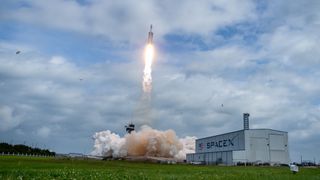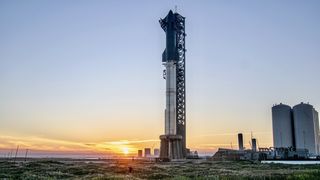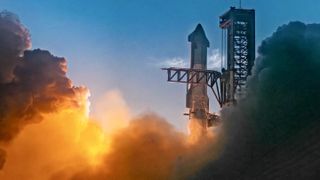SpaceX’s plans to launch its two-stage Starship-Super Heavy rocket 44 times a year from NASA’s Kennedy Space Center in Florida have been criticized by its two main rivals: United Launch Alliance (ULA) and Jeff Bezos’ Blue Origin.
THE Spatialship The vehicle is the world’s largest rocket. Its two stages are SpaceX’s Super Heavy booster rocket and the upper-stage spacecraft known somewhat confusingly as the Starship, aboard which a crew of up to 100 astronauts could one day fly.
After undergoing testing over the past few years, the Starship/Super Heavy design has undergone a number of redesigns, the latest resulting in a rocket that will be up to 150 meters tall. To put this into context, the Saturn V was 111 metres (363 ft) tall, while the manned version of the new Space Launch System is 98 meters tall. SpaceX’s rocket is huge and the plan is to carry astronauts to the moon And March.
Before SpaceX may obtain a license to begin launches from Launch Pad 39A at Kennedy Space Center (KSC) in Florida, an environmental impact study must be provided, detailing the effects that SpaceX’s launches would have on the local environment and wildlife, as well as nearby businesses and residents. This task is being carried out by the Federal Aviation Administration (FAA), and it is currently in the consultation phase, where local businesses, organizations, and members of the public can provide their opinions on the pros and cons of SpaceX’s plans. And, well, SpaceX’s rivals haven’t held back.
Blue Origin submitted a 3-page letter to the FAA, in which they request that a cap be placed on the number of launches and landings, reducing the planned 44 launches to an unspecified number “that has minimal impact on the local environment, local operational personnel and the local community,” they wrote.
THE Blue Origin The objections also include the fact that Starship-Super Heavy will contain “an unprecedented volume” of 5,200 tons of liquid methane, a highly flammable fuel that, if it goes wrong, could cause a devastating explosion on the launch pad. Blue Origin says the safety margins are so wide that they overlap with those of several other companies’ launch pads, hangars and offices, including Blue Origin itself on Launch Pad 36, all of which are leased from Kennedy Space Center.
ULA critics hit even harder in a 22-page document that the company submitted as part of the consultation. They are not shy, accusing SpaceX of having produced its own environmental impact statement for its extravagantly named “Starbase” base in Boca Chica, Texas, from where they have been testing Starship so far.

In the letter, ULA points out that SpaceX’s environmental impact statement suggested that debris from a potential launch incident would cover only one square mile (2.5 km²). In April 2023, during the Starship mission first test flightDebris was scattered over a 6-mile radius, endangering the surrounding area and showing how SpaceX had underestimated the danger to its environment. The explosion led environmental groups to take legal action against SpaceX and the FAA, which was ultimately dismissed by the court. At Kennedy, ULA’s base is located just 3 miles (4.8 km) from SpaceX’s Launch Pad 39A, which understandably makes them nervous.
“With the increased liftoff thrust anticipated for Starship, debris from a similar launch failure could reach larger, more populated areas surrounding KSC,” said ULA, whose recommendation is that SpaceX launch Starship from Boca Chica instead.
“As the largest rocket in existence,” ULA wrote, “an accident would inflict severe, if not catastrophic, damage, while normal launch operations would have a cumulative impact on structures, launch vehicle hardware and other critical launch support equipment.”
On the other hand, Blue Origin has suggested that the government build new launch pads further away from 39A for companies like them that could potentially be affected by SpaceX’s Starship operations.
The environment and local wildlife were also a key concern. To achieve the goal of 44 launches per year, at least 3 or 4 launches per month would be needed, which would allow launch pad 39A to be used year-round. Merritt Island Wildlife Association (Merritt Island is the peninsula on which the Kennedy Space Center is located) noted that floodlights will be on almost everywhere time to 39A, which will disrupt the natural rhythms of wildlife, for example by misleading migratory birds.

Meanwhile, the Defenders of wildlife Florida organizations point out that nesting bird eggs near Boca Chica have been shattered by falling granular debris from previous Starship test flights. Birds are known to nest near Launch Pad 39A, and more frequent launches would be detrimental to the area’s bird population. However, Defenders of Wildlife say they believe using 39A is better than building new launch sites on undeveloped land near Kennedy Space Center, as Blue Origin is proposing, which would also have a significant environmental impact.
A vast investigation by the New York Times published on June 8 details the environmental damage caused by SpaceX’s operations in Boca Chica, noting that the damage has sparked a debate “about how to balance technological and economic advances with the protection of delicate ecosystems and local communities.” While FAA leadership is aware of the environmental problems caused by Starship, the agency has also stressed that the vehicle is vital to America space program.
“We have not recommended dropping debris into national parks or national lands, but the bottom line is that no one has been hurt,” Kelvin B. Coleman, the FAA’s associate administrator for commercial space transportation, told The New York Times. “We certainly don’t want people to feel like they’re being run over by a bulldozer. But this is a very important operation that SpaceX is doing there. It’s really important to our civilian space program.”
Wildlife won’t be the only ones affected by Starship. SpaceX’s water deluge system sprays a million gallons of water onto the pad during launch to protect it from damage during launch by absorbing much of the heat. While much of that water is vaporized, the rest flows into collection ponds around the launch site. ULA is wondering if and how that water will be treated to remove toxic or otherwise dangerous chemicals from it, and what will prevent it from leaking into the larger water supply.

SpaceX also has its eye on a second launch pad. It has applied to use Launch Complex 37 at the nearby Cape Canaveral Space Force Station starting in 2026. The U.S. Air Force is conducting its own environmental review of the project before granting permission.
ULA also questions SpaceX’s decision to stop using offshore drone ships to land the Super Heavy booster and instead land them on 39A, which it says “shifts the risks of system failure onto the communities, businesses and environment surrounding KSC.”
All three companies are competing for the same NASA contracts, and some observers might see the complaints as a sign of souring of SpaceX’s rivals as they struggle to keep up. SpaceX’s Elon Musk responded in an apparently mocking manner to Blue Origin’s complaint on social media: publication of “Sue Origin” on X (the social media company he owns) within days of the company’s letter.
But whatever the motivations for the complaints, many of them related to safety and environmental impact seem relevant. Even NASA has doubts; space agency officials have previously stated that an incident on the launch pad could actually cut off NASA of their only means of reaching the International Space Stationwhich would leave the astronauts stranded.
Blue Origin and ULA’s objections to Starship operations at KSC boil down to the fact that both companies believe the rocket is too untested, too dangerous and too disruptive to fit into the ecosystem of other Kennedy Space Center users.
However, it will be up to the FAA to decide whether these concerns are well-founded and sufficient to prevent Elon Musk and SpaceX to realize their Starship dreams.